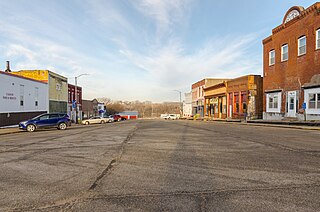
Moulton is a city in Appanoose County, Iowa, United States. The population was 607 at the time of the 2020 census.

Hudson is a city in Black Hawk County, Iowa, United States. The population was 2,546 at the time of the 2020 census. The rural community of Hudson has grown in recent years and is included as a part of the Waterloo-Cedar Falls Metropolitan Statistical Area.

Fairbank is a city in Buchanan and Fayette counties in the U.S. state of Iowa. The population was 1,111 at the time of the 2020 census.

Marathon is a city in Buena Vista County, Iowa, United States. The population was 230 at the time of the 2020 census. The food writer Richard Olney grew up in Marathon.

Pomeroy is a city in Calhoun County, Iowa, United States. The population was 526 at the time of the 2020 census.

Lidderdale is a city in Carroll County, Iowa, United States. The population was 166 at the time of the 2020 census. It was incorporated in 1906.

Mondamin is a city in Harrison County, Iowa, United States. The population was 339 at the time of the 2020 census.

Hills is a city in Johnson County, Iowa, United States. It is part of the Iowa City, Iowa Metropolitan Statistical Area. The population was 863 at the time of the 2020 census. It is part of the Iowa City Community School District.

Havelock is a city in Pocahontas County, Iowa, United States. The population was 130 at the time of the 2020 census.

Laurens is a city in Pocahontas County, Iowa, United States. Its population was 1,264 at the 2020 census.

Palmer is a city in Pocahontas County, Iowa, United States. The population was 138 at the time of the 2020 census.

Plover is a city in Pocahontas County, Iowa, United States. The population was 50 at the time of the 2020 census.

Rolfe is a city in Pocahontas County, Iowa, United States. The population was 509 at the time of the 2020 census.

Varina is an incorporated small, rural village in Pocahontas County, Iowa, United States. The population was 68 at the time of the 2020 census.

Carson is a city in Pottawattamie County, Iowa, United States. The population was 766 at the 2020 census. Carson has a number of interesting and historic places.

Hancock is a city in Pottawattamie County, Iowa, United States, along the West Nishnabotna River. The population was 200 at the time of the 2020 census.

Minden is a city in Pottawattamie County, Iowa, United States. The population was 600 at the time of the 2020 census.

Dixon is a city in Scott County, Iowa, United States. The population was 202 at the time of the 2020 census.

Gilmore City is a city in Humboldt and Pocahontas counties in the U.S. state of Iowa. The population was 487 at the time of the 2020 census.

Bevington is a city in Madison and Warren Counties in the U.S. state of Iowa. The population was 57 at the 2020 census. It is part of the Des Moines–West Des Moines Metropolitan Statistical Area.






















